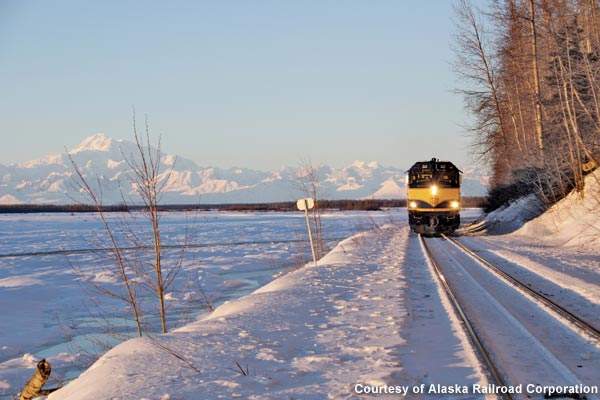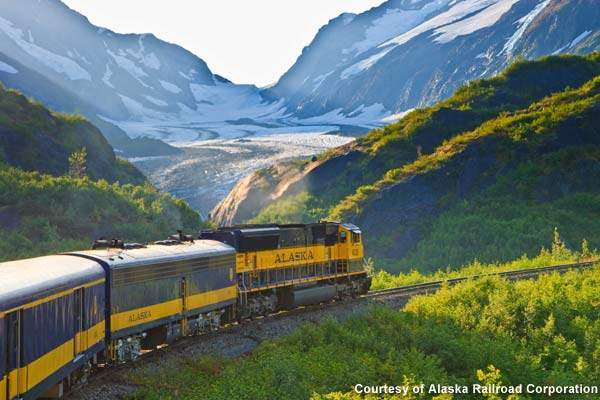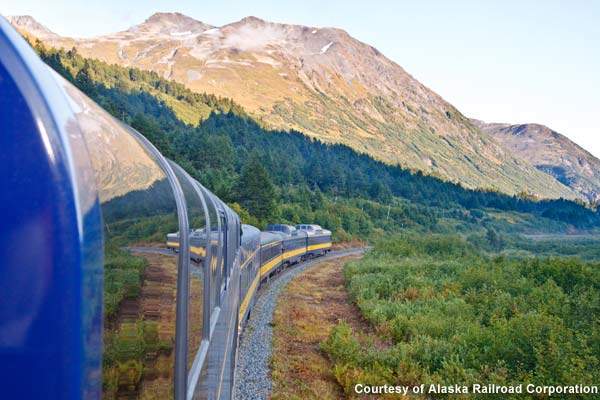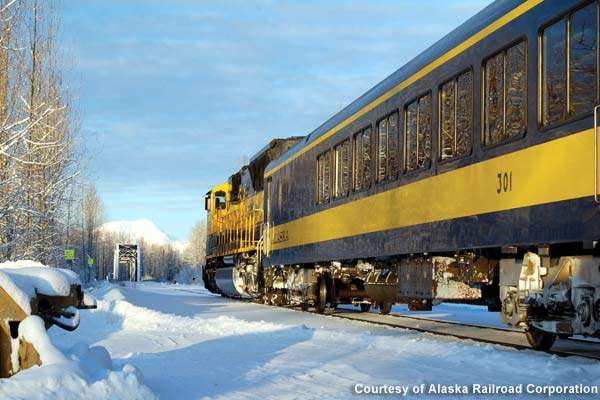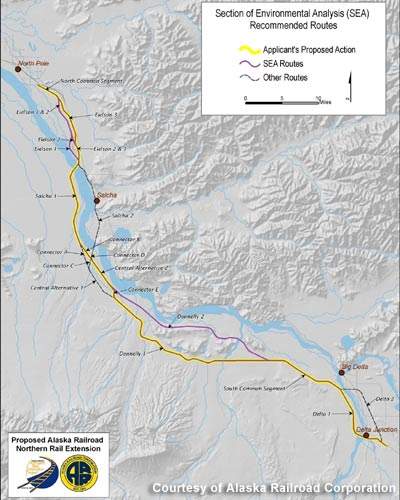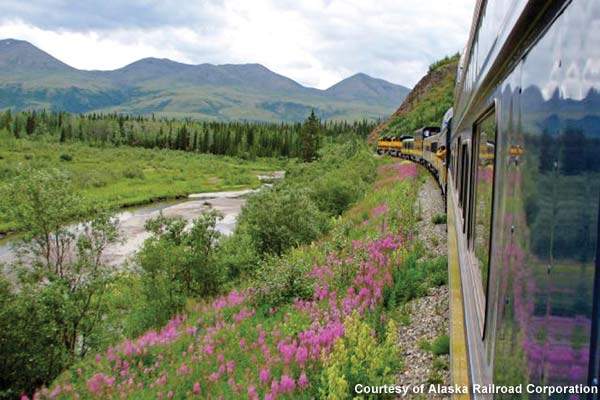Alaska Railroad (ARRC) is planning to build and operate a new 83-mile railway line, known as the Northern Rail Extension, in the state of Alaska, USA. The railway line will be extended from the town of North Pole to the Delta Junction where the access is currently only through airways or roads.
ARRC’s proposal for the extension project received approval from the Surface Transportation Board (STB) on 5 January 2010, provided the ARRC implements a few environmental mitigations.
Alaska Northern Rail extension project
State-owned ARRC operates a 500-mile railway network, which carries both passengers and freight from Seward to the Interior city of Fairbanks in Alaska.
The Northern Rail Extension line will be operated as part of the Alaska Railroad system for transit between Fairbanks, North Pole, Salcha and the Delta Junction. The project will increase the railway connection from North Pole in the Fairbanks to the Delta Junction, and will significantly benefit the regional transportation system.
The line will provide direct access to the training areas for military personnel in the west of the Tanana River and extend commercial civilian freight services to remote areas. This forms an alternative to the Richardson Highway. The extension project will, therefore, help develop Alaska’s economy.
The 83-mile railway line will be constructed to Federal Railroad Administration (FRA) Class 5 track standards where trains run at a top speed of 79mph. The line will provide passenger and freight services in the south of North Pole throughout the year. The procurement process for a general construction contractor for phase one is already underway.
Alaska railway background
Alaska Railroad started conceptual development plans for the Northern Rail Extension in late 2004. As per the National Environmental Policy Act (NEPA), the project required an environmental impact statement (EIS) focusing on total engineering design and identification of alternatives available as well as an estimation of the costs.
The STB selected ICF Consulting for the preparation of EIS as an independent third-party contractor in April 2005.
HDR, Hanson Professional Services and Shannon & Wilson have been engaged in the project along with ARRC to provide the preliminary engineering, programme management and environmental support services for the NEPA process and in the final design for phase one.
The EIS draft was submitted to STB for approval in July 2007. The plan, however, raised concerns about the extension line’s environmental impact. Consequently, ARRC refined the operational and engineering aspects of the potential environmental issues.
In September 2009, the final environmental impact statement (FEIS) was released after the public comments and an environmental review were analysed by the Section of Environmental Analysis (SEA). FEIS focused on identifying potential and environmentally favoured alternatives for the proposed railway line. Following its satisfaction with the FEIS, STB approved the rail line extension, construction and operation in January 2010, subject to some environmental mitigation measures to be taken by ARRC.
The cooperating federal agencies in the EIS preparation were the Alaska Command, Bureau of Land Management, FTA, US Coastguard, US Army Corps of Engineers and US Air Force 354th Fighter Wing, stationed at Eielson Air Force Base, and the Alaska Department of Natural Resources.
Alaska railway extension line routes
Completion of the railway extension project will take place in four phases. The line extension will start near North Pole from the existing Eielson Branch rail line at the Chena River Overflow structure, and will end in the vicinity of the Delta Junction.
Phase one of the line includes the construction of a bridge across Tanana River at Salcha. The final design and construction plan, right-of-way (ROW) acquisition and permitting of phase one will commence late in 2010 and is expected to be completed by late 2013 or early 2014.
The phase two railway line will be constructed from Moose Creek, a census-designated place near North Pole, to the Salcha crossing. Phase two is expected to start in 2012 depending on funding, with plans for it to be completed by 2014.
Phase three railway line construction will be from the Salcha crossing to the Donnelly military training area, and phase four will be from Donnelly to the Delta Junction. Both phases are expected to be constructed at the same time and will each take around three to four years to complete.
Rolling stock
The extension will use the same rolling stock that is currently in operation on the Alaska Railroad. This includes 51 locomotives (28 SD70MACs and 23 GP-38/40), two power cab cars and 48 passenger cars (30 coaches, nine diners, six baggages, two business charter cars and a self-propelled diesel multiple unit). The freight will be transported by 457 fuel tankers (450 owned by a refinery client), 350 flat cars, 460 hoppers, 31 air dumps and 14 box cars.
Alaska railway expansion infrastructure
It is proposed that the Northern Rail Extension Project will have 14 bridges, including a 3,600ft long, dual-use railway and highway bridge over the Tanana River to the Joint Tanana Training Complex of the US military. In addition to the preparation of the EIS, Hanson is providing preliminary engineering services for the Salcha crossing, which includes addressing its hydrological, geo-technical and seismic issues.
Infrastructure development plans also include the construction of a combined-access road for the use of Alaska Railroad maintenance staff and the military, and facilities for passengers, freight and maintenance operations at the railway terminus.
Alaska railway signals and communications
The provision of auxiliary railway support facilities such as wayside signals, communication towers and facilities, power and other equipment to support the transportation and tourism travel, are among the proposed plans for the Northern Rail Extension Project.
The line will be installed with AKRR’s collision avoidance system (CAS), a multi-phased programme for the development and implementation of communication-based train control system, called positive train control (PTC).
The CAS will ensure safe and efficient passenger, freight and roadway worker operations by incorporating data radio communications between train dispatchers and train crews and roadway workers. Completion of the CAS is expected in 2013, by which time the equipment will be installed on all of ARRC’s locomotives.
Alaska rail line project funding
The rail line project is estimated to cost around $650m to $850m. The $16.5m incurred for the preliminary engineering and design and EIS was funded by the Department of Defense (DOD) appropriations and administered by the FRA.
ARRC received funds of $44.2m and $60m through the DOD, which covered the 2008 and 2009 provisions for the engineering, design and construction costs for phase one of the project, the Tanana River crossing. Funding for other phases is expected to be sourced from revenue bonds and federal appropriations.

